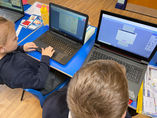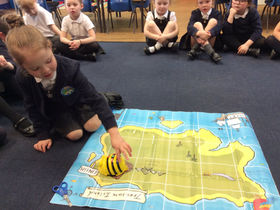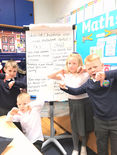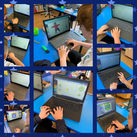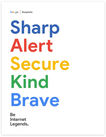Computing
Context
Computing in the National Curriculum replaced information and communication technology (ICT) in 2014. Nationally it was felt that the ICT curriculum focused too heavily on office skills and did not allow pupils to develop knowledge that enables technical innovation. Computing on the other hand is considered to be important, because it has social, cultural and economic benefits. Through computing National Curriculum from Year 1. Recently, there has been a debate on learning computing in the first years of schooling and the importance of getting it right. For this reason, at Murdishaw West, we ensure that all children in EYFS are also taught basic computing education, pupils can learn ‘powerful knowledge’, enabling them to become informed and active participants in our increasingly digital society. Computing is not part of the latest statutory framework for the early years foundation stage, but is part of the skills to ensure they have a good baseline to progress into year 1.
Intent
At our school, we want pupils to be masters of technology and not slaves to it. Technology is everywhere and will play a pivotal part in children’s lives. Therefore, we want to model and educate our pupils on how to use technology positively, responsibly, and safely. We want our pupils to be creators, not consumers and our broad curriculum, encompassing computer science, information technology and digital literacy reflects this. We want our pupils to understand that there is always a choice with using technology and as a school, we utilise technology (especially social media) to model positive use. We recognise that the best prevention for a lot of issues we currently see with technology/social media is through education. Building our knowledge in this subject will allow pupils to effectively demonstrate their learning through creative use of technology. We recognise that technology can allow pupils to share their learning in creative ways. We also understand the accessibility opportunities technology can provide for our pupils. Our knowledge rich curriculum is balanced with opportunities for pupils to apply their knowledge creatively which will in turn help our pupils become skilful computer scientists. We encourage staff to try and embed computing across the whole curriculum to make learning creative and accessible. We want our pupils to be fluent with a range of tools to best express their understanding and hope by Upper Key Stage 2, children have the independence and confidence to choose the best tool to fulfil the task and challenge set by teachers.
Implementation
A useful way of thinking about progression in computing is to consider the 3 main content areas that pupils develop knowledge of:
-
computer science
-
information technology
-
digital literacy
These ‘pillars’ of progression are recognised as areas of the curriculum by the Royal Society and are visible in the aims of the national curriculum for computing. Pupils make progress in computing by knowing and remembering more about and, importantly, across each of these categories, and being able to apply this knowledge. However, these pillars do not sit separately from each other. Knowledge from each pillar complements the others and some subject content only exists at the interplay between these 3 pillars.
Computer science covers knowledge of computers and computation, including concepts such as data, system architecture, algorithms and programming. Computer science is seen as the core of computing and underpins the whole of the subject. Because of this, it is fair to say that computer science provides the foundational knowledge required to understand and interpret the other areas of the computing curriculum. Therefore, it is important that any computing curriculum is rich in computer science knowledge so for this reason we use the Kapow scheme to support the teaching of this element & the IT element of the curriculum. These knowledge and skills are then embedded across the curriculum.
The National Centre for Computing Education defines digital literacy as the ‘skills and knowledge required to be an effective, safe and discerning user of a range of computer systems’. It covers a range of knowledge and skills, such as using physical devices or knowledge of the features that are likely to mean digital content is reliable.
Digital Literacy (Online Safety) at Murdishaw West is delivered using guidance from the Kapow scheme of work, which is linked to the Education for a Connected World document. We ensure that knowledge, skills, behaviours and attitudes across the eight strands are mapped to age and progression.
Computer Science is taught in half-termly units so six computing studies are undertaken in all classes apart from EYFS (Robins) who use autumn 1 to introduce computing through continuous provision so study five complete units. Years 3, 4 and 5 use a three-year cycle to ensure all children in mixed-age classes access the complete computing curriculum.
Impact
We encourage our children to enjoy and value the curriculum we deliver at Murdishaw West Community Primary School. We will constantly ask the WHY behind their learning and not just the HOW. We want learners to discuss, reflect and appreciate the impact computing has on their learning, development and well-being. We talk about ‘sticky knowledge’ and ensure previous knowledge and skills are revisited in our knowledge retrieval grids. Finding the right balance with technology is key to an effective education and a healthy lifestyle. We feel the way we implement computing helps children realise the need for the right balance and one they can continue to build on in their next stage of education and beyond. We encourage regular discussions between staff and pupils to best embed and understand this. The way children showcase, share, celebrate and publish their work will best show the impact of our curriculum. Finding out what the children are interested in online is extremely important to ensure we as adults can support and educate them about the technology they are using in the best way. We also look for evidence through reviewing pupil’s knowledge and skills digitally through tools like Seesaw and observing learning regularly. Progress of our computing curriculum is demonstrated through outcomes and the record of coverage in the process of achieving these outcomes.









